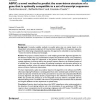6 search results - page 1 / 2 » ASPIC: a novel method to predict the exon-intron structure o... |
BMCBI
2005
13 years 4 months ago
2005
Background: Currently available methods to predict splice sites are mainly based on the independent and progressive alignment of transcript data (mostly ESTs) to the genomic seque...
ALMOB
2006
13 years 4 months ago
2006
Background: An important challenge in eukaryotic gene prediction is accurate identification of alternatively spliced exons. Functional transcripts can go undetected in gene expres...
RECOMB
2005
Springer
14 years 5 months ago
2005
Springer
Abstract. Current approaches for identification and detection of transcription factor binding sites rely on an extensive set of known target genes. Here we describe a novel structu...
BMCBI
2006
13 years 4 months ago
2006
Background: Identifying functional elements, such as transcriptional factor binding sites, is a fundamental step in reconstructing gene regulatory networks and remains a challengi...
BMCBI
2008
13 years 4 months ago
2008
Background: Translation initiation site (TIS) identification is an important aspect of the gene annotation process, requisite for the accurate delineation of protein sequences fro...

